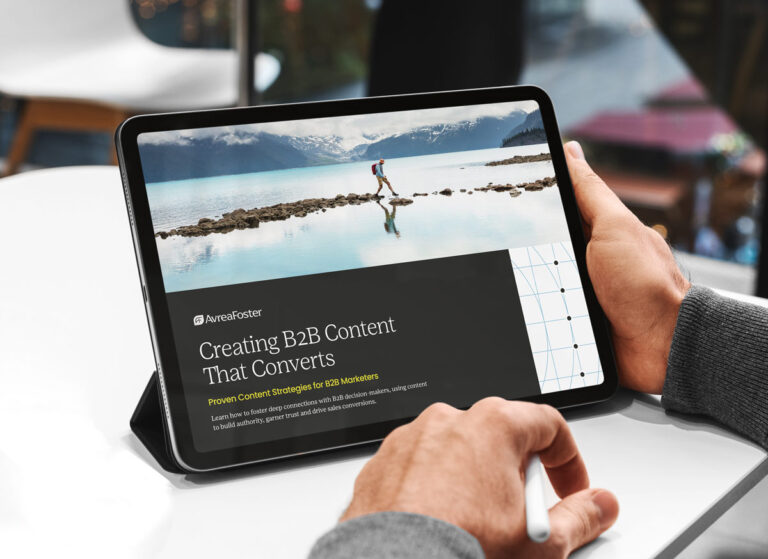AvreaFoster has been leading corporate communication initiatives for clients since opening our doors more than 30 years ago.
Over the years, as employee engagement has become increasingly important to creating and maintaining a positive company culture, our https://avreafoster.com/services/internal-communications/communication strategies have evolved — and we’ve gotten smarter in the process. Here are our insights on 13 lessons learned during more than a quarter-century of managing employee communications projects for clients big and small.
01
Corporate communications is hard work.
Here’s the reality: corporate communications is a complicated, strategy-driven discipline that challenges even the best communicators. A recent report found that 56% of companies struggle to keep employees engaged and informed. The first step of any successful communication strategy is to acknowledge that it’s hard work — something that takes time, effort and resources. Once you understand the complexity, you’ll be ready to outline your plan.
02
Get your executive team on board.
In order to be successful, you must get buy-in from your executive team, especially since leadership visibility is a key component of every viable strategy. And let’s face it, you really need their financial support. With executive backing, you can carve out a proper budget and then build a team that can develop the strategy, create the deliverable and execute the plan.
03
Disengaged employees are bad for business.
There’s a direct correlation between disengaged employees and poor business performance. A recent Gallup study found that, on average, companies lose $62.4 million annually due to poor internal communications. When employees are informed and engaged, productivity increase 20% – 25%. (That’s a stat that should pique the interest of your executive team.) Engaged employees also improve retention, recruitment and company culture — all components that contribute to a healthy and profitable business.
04
Don’t jump into the pool without knowing how deep the water is.
Before you launch your employee engagement strategy, it’s important to build out a comprehensive plan. While every company is different and every plan is typically customized based on business goals, there are some basic steps you need to follow before you take the plunge:
- Outline what success looks like upfront.
- Establish a budget and build out a team.
- Define your voice and purpose (more on that in Lesson 5).
- Identify your core audiences (more on that in Lesson 6).
- Build a 12-month calendar with key milestones and dates.
- Track performance and make adjustments every 90 days.
- Be agile, nimble and ready to make changes on the fly.
05
Before you speak, find your voice.
Do you have a well-defined company purpose? What’s the preferred tone of your communication? Does it lean professional or more casual? What are the values that define your culture? These are all questions that should be answered before you start creating actual deliverables. So, spend some time developing a foundational platform, complete with your Purpose Statement, Corporate Values and key messages.
06
Your workforce is not an audience of one.
Chances are your employees are a diverse bunch, ranging in age, location and title. Rather than take a one-size-fits-all approach, you need to understand your audiences, build out employee personas and segment communications based on their unique communication preferences. The more you know about them, the better equipped you’ll be to make long-lasting connections.
07
Identify your key ambassadors and influencers.
Every company has those brand ambassadors who react positively to your outreach efforts. They answer surveys. They like your social posts. They participate in company events. Go ahead and encourage their efforts. Ask them to write a company blog or invite them to an employee-only council so they can guide future projects. Acknowledging and rewarding their behavior will go a long way.
08
Don’t underestimate the importance of your millennials.
I’m willing to bet that millennials make up the majority your employee base. So, it’s important to pay attention to their needs and understand what makes them tick.
The individuals in this demographic:
- Want to work for a purpose-driven company.
- Value a positive company culture.
- Like to be challenged in the workplace.
- Take pride in their performance.
- Want to be recognized when they do a good job.
- Like to communicate with managers and C-level executives.
09
Not sure what stories your employees want to hear? Just ask.
A survey is a great place to start your research. Ask your employees what types of information they want to hear, how they like to communicate, what social channels they use. Tools like SurveyMonkey are an easy way to quickly and cost-effectively gather data. More sophisticated platforms like Officevibe can also help track and improve ongoing engagement.
10
Look beyond the basics.
Communicating through standard communication channels, like a company intranet, email and printed materials, is a good place to start. But be sure to look beyond the basics. Use social media channels like Facebook, LinkedIn and Instagram to share timely company news.
- Create private social pages specifically for employees.
- Incorporate channels like Slack and Yammer into your overall plan.
- Tell your stories visually by integrating photography and video where it’s a natural fit.
- Consider creating employee-specific deliverables like an employee annual report to share metrics, promote your big-picture vision and communicate long-term goals.
- Incorporate tools like Social Chorus or Dynamic Signal to manage communications.
11
The world is addicted to smartphones. And so are your employees.
Nearly all the U.S. workforce has access to a smartphone, 95% to be exact. It’s how the world communicates. That’s especially true if you have a remote workforce that does not have access to desktop computers. When you’re creating materials, think of the mobile-first environment and consider investing in digital channels like employee-only apps that allow you to share information in a timely and targeted manner.
12
Be prepared to be punched in the mouth.
To quote Mike Tyson, “Everyone has a plan, until they get punched in the mouth.” As a communicator, you have to be prepared for all types of company news, even the bad stuff. So have a plan in place but be prepared to alter that plan without sacrificing the core tenets of your purpose and platform (those things you defined in Lesson 5). Always be transparent and honest with your employees. They will see through any sort of fabricated narrative.
13
Remember, this is supposed to be fun.
You’re communicating with colleagues — these are your teammates, your friends, the people you spend more waking hours with than your family members. Ditch the stuffy tone. Be empathetic and understanding. Make them laugh. Find those opportunities to be honest and real. It’s the best way to make connections that last.
When you’re ready to launch your next employee engagement initiative, give us a call. We’re ready to leverage the lessons we’ve learned and build them into your next project.



